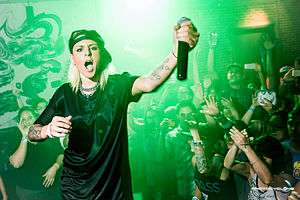Concert photography

Concert photography is the photography of activities relating to concerts and music. It encompasses photographs of a band or musician as well as coverage of a concert. It is a minor commercial endeavor that supports in part of the efforts for many independent photographers.
History
Like the technology of photography itself, the practice of photography has evolved and grown since the invention of the photographic art form in 1826 by Joseph Nicéphore Niépce.[1] Concert photography began becoming popular with the advent of Rock & Roll, particularly during the height of popularity by such bands as The Beatles or the Rolling Stones. During the 1950s and 1960s, the desire for memorabilia was increased with every new musician or music group.[2] During that time, some of the more respected music photographers included Gered Mankowitz (Rolling Stones), Robert Altman (Rolling Stone Magazine) and Ethan Russell (Jim Morrison) amongst others.[2]
Technology
During the film era, photographers favored color negative film and medium-format cameras, especially by Hasselblad. Today, many more concerts are photographed with digital SLR cameras as the digital convenience provides quick detection of lighting mistakes and allows creative approaches to be reviewed immediately. In spite of diminishing film use, some concert photographers continue to shoot with film as they prefer the film aesthetic, and others are of the opinion that negative film captures more information than digital technology, and has less margin for exposure error. Certainly true in some cases, it should be noted that exposure latitude inherent in a camera's native Raw image format (which allows for more under- and over- exposure than JPEG) varies from manufacturer to manufacturer. All forms of RAW have a degree of exposure latitude which exceeds slide film - to which digital capture is commonly compared.
Three song rule
The three-song rule, only allows some concert photographers to shoot photos for the first three songs. During interview with Paul Natkin, widely condsidered as one of Chicago's greatest music photographers,[3] he stated "The Rule started in the 80s with bands in New York, especially Springsteen. When a band played in New York, especially places like the Garden, they gave out tons of photo passes. At least half to paparazzi guys. Those people don't know how to photograph, their only option is to put a flash on a camera. A lot of people didn't even know how to change film, they knew they only had 36 shots. They were just doing it for the excitement of doing it. Bruce would go up on stage, and there would be 50 photographers, all shooting flashes in his face. I don't blame him, he walked off stage one night and said, we have to do something about this. Somebody said, why not just let them shoot the first fifteen minutes? Somebody figured out at a normal rock show, a song is about five minutes. Somebody said, let's just let them shoot the first three songs. So it started with him and people in that era. It was also that MTV started around that time, and everybody wanted to look perfect, the way they looked in their videos."[4] According to a July 21, 2013 popphoto.com article, it could be for appearances; the artist looks best at the beginning of the show.[5]
References
- ↑ Baatz, Willfried (1997). Photography: An Illustrated Historical Overview. New York: Barron’s. p. 16. ISBN 0-7641-0243-5.
- 1 2 Gighive:Music Photography History Came to Life with Rock & Roll
- ↑ City of Chicago:Shutter to Think: The Rock & Roll Lens of Paul Natkin
- ↑ InStudioOnLocation:Sean Williams
- ↑ DePaulOnline:Bragging Rights Cameras at Concerts
Beate Sandor • showtime, Kings & Queens from A to Z music (mainly blues) history of a decade in 128 full page musician photo portraits (2016) ISBN 978-3-200-04632-0